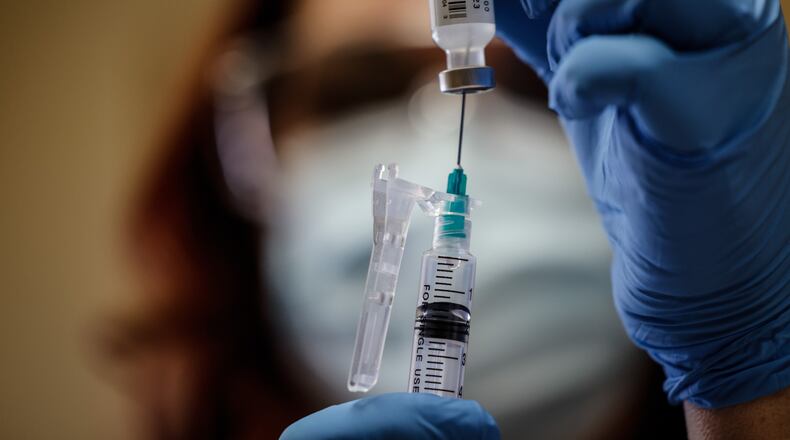Schools and businesses have shut down, disrupting lives and incomes. Public safety infrastructure is strained.
But health experts say we have the tools to beat this — and now is a time for action.
The Dayton Daily News Path Forward project investigates solutions to the greatest challenges facing our region. This story is the beginning of a series on how the community can overcome this COVID-19 crisis and prevent another one.
During a community conversation hosted by the Dayton Daily News on Thursday, leaders from Premier Health, Kettering Health and Dayton Children’s Hospital pleaded with the community to get vaccinated to alleviate the burden on hospitals.
“You can’t ignore it away,” said Dr. Roberto Colón, chief medical officer at Miami Valley Hospital. “What we need to do is really focus on what we can do to change the tide. It’s exhausting when you hear about a disease and you feel powerless to impact it. We are not powerless. We can choose to wear the masks. We can choose to avoid those large gatherings, we can choose to as a community do a better job with vaccinations and reduce all those (hospitalization) numbers.”
Experts say the Omicron surge — the most devastating wave yet — is likely peaking here. That doesn’t mean it’s over. Without interventions, just as many residents could suffer on the back half of this curve as the front half.
And the current situation is dire:
- Intensive care units at local hospitals are overflowing. Local ICUs are averaging over 90% capacity, according to a Dayton Daily News analysis of federal data. This has led to emergency room patients waiting days in ERs for ICU beds to come open, hospital officials say.
- COVID hospitalizations reached an all-time high last week in the Dayton region, when 652 people were in the hospital with COVID-19 on Monday. In the Cincinnati region, including Butler and Warren counties, hospitalizations appear to have peaked on Jan. 19 with 1,033 in the hospital.
- Of the total 2,893 area residents hospitalized since Dec. 1, 694 were younger than 50, and 100 younger than 20.
- The Greater Dayton Area Hospital Association recently reported that 84% of hospitalized COVID-19 patients weren’t vaccinated; in the ICU, it was 89%.
- COVID patients account for more than a third of inpatients and ICU patients at local hospitals, according to federal data.
- Schools, child care centers and businesses have struggled to stay open as they deal with staff shortages because of COVID. More than 4,000 COVID cases have been reported among staff at local school districts this school year.
- Since the beginning of December, nearly 650 area residents have been killed by COVID-19, including 42 younger than 50. Roughly 83% of COVID deaths reported by the area’s largest hospital chains in the last month were people not vaccinated against COVID.
This strain on the health care system is impacting emergency medical care. Local hospitals say there were 18 instances in the past 90 days where they had to enter a mode of asking emergency squads to divert to a different facility because of bed and capacity issues caused by COVID.
In recent weeks, Miami Valley Hospital enclosed the canopy in front of its building to provide extra triaging space for high emergency department volumes.
“This is nothing like I’ve ever seen,” said Dr. Randy Marriott, emergency department physician at Premier Health, who has practiced for 30 years.
He said having to keep 20 to 30 admitted patients in the emergency department per day was unprecedented, and the lack of available beds left some waiting 30 to 40 hours in the ER for one.
That’s led to hours-long emergency room wait times, during which some people leave before being seen, he said.
“When someone leaves without treatment, we know that’s a very risky situation,” Marriott said. “But we don’t have the space on some of these days. We simply can’t put them in a bed in a reasonable period of time.”
At one time recently, five floors of Miami Valley Hospital were full of COVID patients in a high-risk respiratory unit, Marriott said. These are patients admitted because of COVID, not found to have COVID after being admitted for something else.
“You look at the largest portion of Miami Valley Hospital, and imagine that half full of COVID patients. That’s literally what the situation was,” he said.
Demands ‘historic’
Every area hospital is in a similar situation, according to U.S. Department of Health and Human Services data analyzed by the Dayton Daily News.
Hospitals can and do increase the number of available ICU beds to account for increased numbers, but there is a limit dictated mostly by staffing levels. During the week of Jan. 14-20, roughly 39% of the occupied ICU beds were COVID patients. This left several hospitals over 90% of their ICU capacity, the Dayton Daily News analysis of federal data found.
“The demands placed on the region’s hospitals by this latest surge in COVID-19 cases are historic and severe, and those demands are reflected in this data set,” said Sarah Hackenbracht, president of the Greater Dayton Area Hospital Association.
Patient volumes have always fluctuated.
“However, the challenge for our region’s hospitals involves the combination of high patient volumes, high acuity of COVID-19 patients, and limited staffing that results when numerous health care staff are out ill with COVID-19,” she said.
Dr. Jeffrey Weinstein, patient safety officer at Kettering Health, said hospitals are able to transfer patients and share the load — but it’s been tight.
“But there’s been a lot of pressure on our intensive care unit beds because of all the patients sick with COVID, as well as all the other patients with heart attacks and stroke, etc.,” he said.
Lack of staff also had made it difficult to meet the high volume of very sick patients.
When cases were extremely high in recent weeks, hospitals had hundreds of staff members out every day with the virus. The staff shortage got so bad that in mid-January, Springfield Regional Medical Center updated its guidelines to allow COVID-positive staff to continue working without quarantining.
The path forward
The good news is at the end of the wave, Omicron will likely leave large swaths of the population with some immunity, but that is likely only temporary. Immunity wanes and another variant could be just over the horizon.
Health leaders say we must recognize how devastating this wave has been and prepare so we never face a surge like this again.
Central to this is getting people vaccinated against COVID-19.
The vaccine isn’t a magical suit of armor. People who are vaccinated can still get COVID, and even die from it. But health experts say the science clearly shows that increasing vaccination rates will decrease hospitalizations, deaths and community spread.
“None of us expected that with a vaccine, we would never get any symptoms or never contract an illness. What we expect is we won’t get as severely ill or even die from this. And sometimes the message gets lost that that’s a huge victory,” said Dr. Adam Mezoff, chief medical officer at Dayton Children’s Hospital. “Because somebody who’s been vaccinated happens to get sick isn’t a failure. In fact, if they’re still at home, it’s a victory,”


